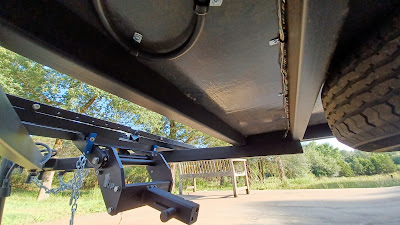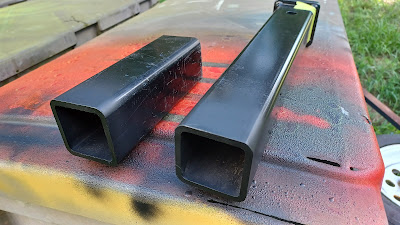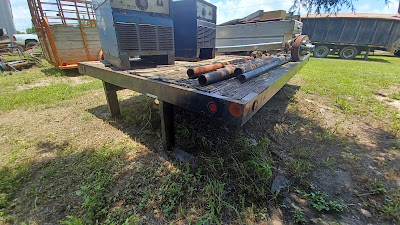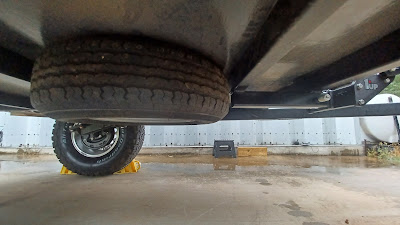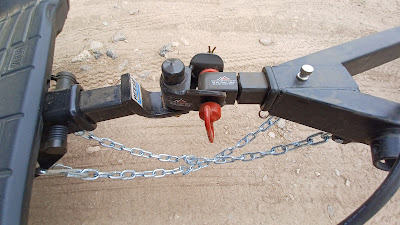I seem to be leaning into a trend of revealing more of
myself since I returned from my cancer hiatus. Still not convinced that’s good,
but recently I made a comment on another blogger’s post and the response from
the blog owner was along the lines of WHEN was I in England, WHAT enticed me to
go to France, and HOW could I possibly not like the French food in France?!! (That’s right. Blame the other guy for what follows! BTW I had some photos picked
out of our datacenter infrastructure and the computers in those datacenters,
but after thinking about it, decided not to use them because, even though most
were of outdated crap, they really aren’t mine to be publishing.)
OK, let’s start with the first two. When and what, England
and France.
But first, between the military and my civilian job I
actually spent a lot of time in a variety of places. Something that I take for
granted because I’ve lived it, but apparently somewhat surprising to others.
Some of those places were good – in the 90’s, Caracas, and northern Venezuela
in general was hectic, confusing, contradictory, a little dangerous, but
vibrant and driven on hope, and the food! Talk about exquisite flavors without
pomp and pretense! – some downright bad – Lagos Nigeria in the 80’s was dirty,
hopeless, perilous, and something to be endured (once! only once!). Shell Oil
bought an island, built a small day-resort, locked it down, and would ferry
expats and family out there for a few hours of “normal” away from Lagos. – some
were idiosyncratic to my American sensibilities – in Singapore you can buy packages
of bananas sorted by days (eat this one today, the next one tomorrow, and so
on. Someone sits there, breaks down bunches of bananas, sorts them by ripeness
then packages them in trays labeled with the days of the week, the ripest on
the left, the next ripest in slot 2, and so on.), but the only way you could buy a razor in Singapore, even the
disposables, was to get a clerk to open up the locked cabinet. And in England
the shops close at 1700, malls, convenience stores, you name it, shut up tight.
No wonder the characters in Midsummer Murders are always buying gas-station
flowers on their way home! Only place open. – some were deceptive –
Villahermosa Mexico is anything but a beautiful view! (My grandmother used to live in San Miguel de Allendein the late 60's/early 70's, so I know what a beautiful Mexican View is, and it's not Villahermosa!) – some were contradictory
– 90’s Columbia was beautiful, but if you fiddle with the hotel restaurant’s
window-coverings during breakfast you will firmly be told to leave the
blast-curtains alone.
There were a few places I REALLY didn’t want to be, but for
the most part visiting other places was interesting, though honestly, as a
military person my schedule was pretty well dictated and full, and as a
civilian I was usually focused on my work and not playing tourist. Though there
were some exceptions.
One morning I made an emergency flight to Caracas (I
always kept an overnight bag under my desk because this wasn’t unusual.) because
one of the two main-frame computers there went down late the day before and the guy on
the ground couldn’t get it going again. I touched down in the afternoon with a dozen
or so boxes of parts, which I had to get through customs right behind a guy
with a weapons catalog in his bag, to find that the center manager had not only
banned the on-site tech from the computer room first thing that morning, but
also from even meeting me at the airport, his assistant was there instead. Somewhere
around 0200 the assistant and I had the computer up and running again with a
part that had already been on site, but by the time I woke up the next morning on
the floor in his office, the former on-site tech was already back in the US and
I stayed there in Caracas for 6 weeks, exploring the streets, jungles, and
beaches, while they found someone to replace him. (That year I was away on
assignment, training, or conference for 11 out of 16 weeks running, and this
was over the Thanksgiving/Christmas period). And we had an operation in Anchorage
that was treated like a foreign assignment, so for a number of years I would go
up and live in their house while the company flew the computer tech and his
wife back to the lower 48 for their 6 week annual leave. It was a small center
and took about 2 hours a day of my time to keep running, so I did a LOT of
hiking in south-central Alaska during those years, and as an added bonus, during
one of those years watched Mount Spur erupt from their front porch.
But back to England. We had two data-centers there in southern
England about a half-hour train-ride apart, so I was there doing my thing
several times. (Here’s a tip, use public transport during the week, but when
you rent a car for a weekend excursion, insist on a manual shift. That way you
are always using the “wrong” hand which constantly reminds you to stay on the “wrong”
side of the road.)
I guess that leaves France and my
less-than-up-to-expectations experience with French food. I will admit, I was biased against the
French, at least the French business culture, long before I was exposed to the
food, but I’m getting to that. And remember, what follows is my experience and my opinions resulting from that experience. (And my exposure was to French business people.
I don’t claim to know what regular French people are like.)
Some additional background here. After military service and
a couple of subsequent, short lived jobs (3 years or so each) I worked for the
same company for 31 years. But it changed names and leadership several times
during that period. The first major change was a “merger” (I put that in quotes
because in my experience, rather than actually playing nice together, that’s just
a term used to sugar-coat the fact that one company is going to try to ride
roughshod over the other) between a US based company (The one I was with) and a
Canadian company. Years later, when the Canadian born CEO of the resulting
company decided to retire, rather than promote from within (there was a candidate
that had been specifically groomed for years for the position but he, an
American, was ultimately passed over), he chose to bring in a complete ringer
instead (I hope he spent his retirement kicking his ass for that, as the company
he spent his life building up and banked his retirement on tanked! Well at
least dropped from industry leader to just another of the mediocre pack.) His
ill-considered pick was a Frenchman. And that Frenchman, after unsuccessfully trying
to tear the heart out of the company culture, barely let the ink dry on his
contract before selling the company off to one of his cronies running a similar
French company in yet another one of those “mergers”.
An important detail of my civilian career. I was on the data
collection and processing side of the oil and gas business. A field that prospers
by being on the cutting edge of technology. Something that dovetails very
nicely with the American culture which is largely made up of 900 or more years
of people making the leap into the unknown and collectively prospering by
riding that cutting, sometimes bleeding, edge. Oddly enough given our similar
historical trajectories, Canadian culture is not quite so “wild west”, it’s a
little more reserved, but as a company we managed to hash that cultural
difference out and stay out there on the cutting edge and continued to build
one of the premier outfits in our field.
Now you may already know this about French business men, I
didn’t until I started working with them, but they are scared to death of
making a mistake. They make Asians look like amateurs when it comes to “saving
face”. I don’t know if that’s an ingrained thing across the population or if it’s
beaten into them by their precious business schools (I’ll come back to the
schools in a moment). Because of this fear of “failure” they tend to sit back
and let somebody else take the risk first, if it works, maybe, but only maybe,
they’ll give it a try. Not a good fit for the field I was in.
The way to stay on the cutting edge in the technology field,
which moves at lightning speed, is to occasionally step across the line and get
bloodied. That’s the only way to know where the cutting edge is! I used to tell
my team-members that if they weren’t making mistakes once in a while they weren’t
doing their jobs. And that didn’t sit well with my Gallic bosses. And when you
piss off one French boss you piss off all the French bosses right up the chain.
The French businessman is also obsessed with the school he/she
went to and will only gather minions and cronies around themselves that are from
the same school. When a high-ranking Frenchman moves into a position you can be
sure the whole structure is going to be decimated because they insist on
bringing their familiar, school-vetted entourage with them, filling all the nearby
positions with known entities and getting rid of those pesky unknowns.
I was used to quick, informal meetings where multiple disciplines
came together as equals, usually in a mix of in-person and video feeds since we were scattered all over the world, and hashed out ideas, worked towards solutions, and
came to a group consensus on how to proceed. That’s not the way French business
meetings work. In a French meeting, which are highly structured and go on
interminably, they go around the table, which has been carefully stacked by
rank and importance, and each person presents their data and recommendations.
There’s no discussion, no back-and-forth, no exchange of ideas. Then the head
person gathers up their notes and walks out of the room. No decision, no plan
of action. Sometime later, after they have digested the often misinterpreted
information they collected and made an autocratic decision, they will let the
peons, who have been sitting around twiddling their thumbs while the rest of
the industry is charging forward, know what to do.
With all the traveling, advising, and consulting I did for
the many company locations scattered around the world, I never went to France, the
global company headquarters during those last years, not in my professional
capacity anyway. Because, although they were happy to milk my skills and
expertise in other locations, they could handle their own business in France
with their own people thank you very much (Boy did they make a hash out of designing
what was supposed to be a “showpiece datacenter”!). So I stayed away from
France until the powers-that-be finally got fed up with the lack of progress in
resolving the ongoing cultural clashes within the company.
Their solution was to hire a mediator and a corporate
trainer then “invite” key personnel (No upper management because, of course,
they weren’t the problem) to an intensive 5 day “workshop” to be held at a
hotel on the south side of Paris (They couldn’t let something like this get too
close to the corporate headquarters located in Paris proper lest there be some cross-contamination!).
By intensive, I mean full days of formal, scripted sessions
starting with breakfast and ending with dinner, then we were broken into teams
and sent off with “homework” for the evening. And to make sure we stayed on
track, our sleeping quarters and meals were part of the program. That wasn’t an
issue. I went through the same intensive, immersed thing when completing my MBA
at a local (local to my usual office in Houston) university during their summer
break when we had run of the campus, including the nearly empty dorms, and pick
of the professors looking to make a little extra spending money between
semesters.
No, other than the cultural issues, the main point of contention
during this workshop, if you discount the two hours the company head (Frenchman
of course) sat down in front of us with his henchmen on either side (why is
there always an entourage standing around behind the police or fire chief or
mayor during crisis press conferences? Shouldn’t
they all be off doing what they’re paid for instead of standing around and
uselessly nodding at what their boss is saying?), went on a rant and berated us
for the very thing we were there to resolve, was the food. Breakfast, lunch,
dinner, and snacks, didn’t make any difference, it was dictated, scheduled, no
substitutions, and universally atrocious!
Now to be fair, I already had a bad attitude of all things
French by this point, but I wasn’t alone in thinking the food was just plain bad.
It was unpalatable enough that after a day and a half of chocking down slop a senior
attendee told the hotel catering staff that we were done and would be ordering
our meals off the general menu from here on out. The head of catering agreed,
but not until after tomorrow night because the chicken cordon bleu had already
be removed from the freezer and was thawing - - -
So that’s why my take on French food in France is to not –
take it that is.
The session ended mid-day Friday and I, nor anyone else that
I know of, didn’t hang around to test our new “camaraderie”. I grabbed my computer-bag, which doubled as my
luggage for most of my trips, snagged a taxi out front, fortunately the driver
spoke Spanish because I had, still have, no French, had him take me to the
nearest station, grabbed a train up to the Paris Gare du Nord station where I
grabbed a Eurostar to London, a taxi to Crowley, and was sleeping in a room of
my choice that night after eating food I selected myself, before spending
another week or so bouncing between the two UK datacenters trying to put that disastrous
French interlude behind me and do the job I was being paid for.
For the first 26 years I worked for that company it was a
blast. I was traveling around, elbow deep in technology, dreaming up new ways
to utilize and push that technology, actually getting to try out many of those hair-brained
ideas, building datacenters based on my designs with multi-million dollar budgets
based on my say so (the first time a company VP said “whatever it costs, it’s
your project” I was scared to death, even though I knew I was right, and got
pretty obsessive about triple and quadruple checking everything!).
The next three years I saw things slipping away, literally,
as the company went from being a premier choice of clients, mostly oil
companies, big and small, to just another one of the pack.
The last two years pretty much sucked. The only reason I
didn’t bail out in the middle of that French session while being yelled at by a
pissed off, completely out in the weeds, French upstart was because I had already selected a retirement date
and was going to leave after the previous year’s bonuses were paid out in
March.
There were some rough patches, but overall my working life
from 1972 to 2012 (longer if you count summer jobs) was a good run. I can even
see the good side of working with the French now. Because of that experience I
have cherished every day that I don’t have to go in to work and put up with their
corporate and cultural crap.
But that doesn’t mean I have any interest in going back to
soak up their contrived culture. I’m not impressed by the food I was exposed to
during my one trip there, and since I’m not a foodie, not really driven to try
again despite the gastronomical hype. The most famous painting in the most
famous French museum was painted by an Italian. Yes, France has some notable,
home-grown artist, but when you think about it, the best artists have always
been societal outliers and, despite the best efforts of the appropriationists ,
don’t exactly represent the cultures they came from. It’s like someone that
hasn’t really done anything of note themselves trying to appropriate the glory
of their movie-star grandparent. (OK, that’s perhaps a little harsh, but
writing this has got me all riled up all over again, so screw-em!)
Well that turned into a bit of a rant! But hopefully answers
some questions for at least one reader.













